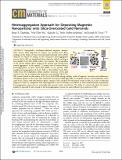Heteroaggregation Approach for Depositing Magnetite Nanoparticles onto Silica-Overcoated Gold Nanorods
Author(s)
Chapman, Brian S; Wu, Wei-Chen; Li, Qiaochu; Holten-Andersen, Niels; Tracy, Joseph B
DownloadPublished version (3.101Mb)
Terms of use
Metadata
Show full item recordAbstract
© 2017 American Chemical Society. Hydrophobic, oleylamine-stabilized magnetite nanoparticles (Fe3O4 NPs) dispersed in hexanes can assemble into dense coatings on the surface of silica-overcoated gold nanorods (SiO2-GNRs) dispersed in ethanol by mixing. In this nonaqueous heteroaggregation process, Fe3O4 NPs are destabilized when ethanol is added, resulting in core/satellite Fe3O4-SiO2-GNRs within a few minutes. The composition of the solvent mixture allows tuning of the polarity and driving forces toward aggregation. At the optimal 2:1 volume ratio of hexanes:ethanol, heteroaggregation to form Fe3O4-SiO2-GNRs occurs quickly, while avoiding homoaggregation of Fe3O4 NPs or SiO2-GNRs. Fe3O4-SiO2-GNRs retain the longitudinal surface plasmon resonance of the gold nanorod cores and are magnetically responsive and separable. The Fe3O4 NPs remain bound on the surface of the Fe3O4-SiO2-GNRs during multiple cycles of magnetic extraction and redispersion. Oleylamine ligands on the Fe3O4 NPs render the Fe3O4-SiO2-GNRs dispersible in nonpolar solvents. Functionalization of the outer Fe3O4 surface with poly(ethylene glycol) catechol (PEG-catechol) for PEGylation results in PEG-Fe3O4-SiO2-GNRs that disperse in water. In comparison with seeded growth or use of molecular cross-linkers to form multifunctional nanoparticles, heteroaggregation approaches are potentially quite general, simple, and efficient. The ability to continuously adjust the solvent polarity is expected to allow tuning of the heteroaggregation process for many different types and sizes of NPs.
Date issued
2017Department
Massachusetts Institute of Technology. Department of Materials Science and EngineeringJournal
Chemistry of Materials
Publisher
American Chemical Society (ACS)